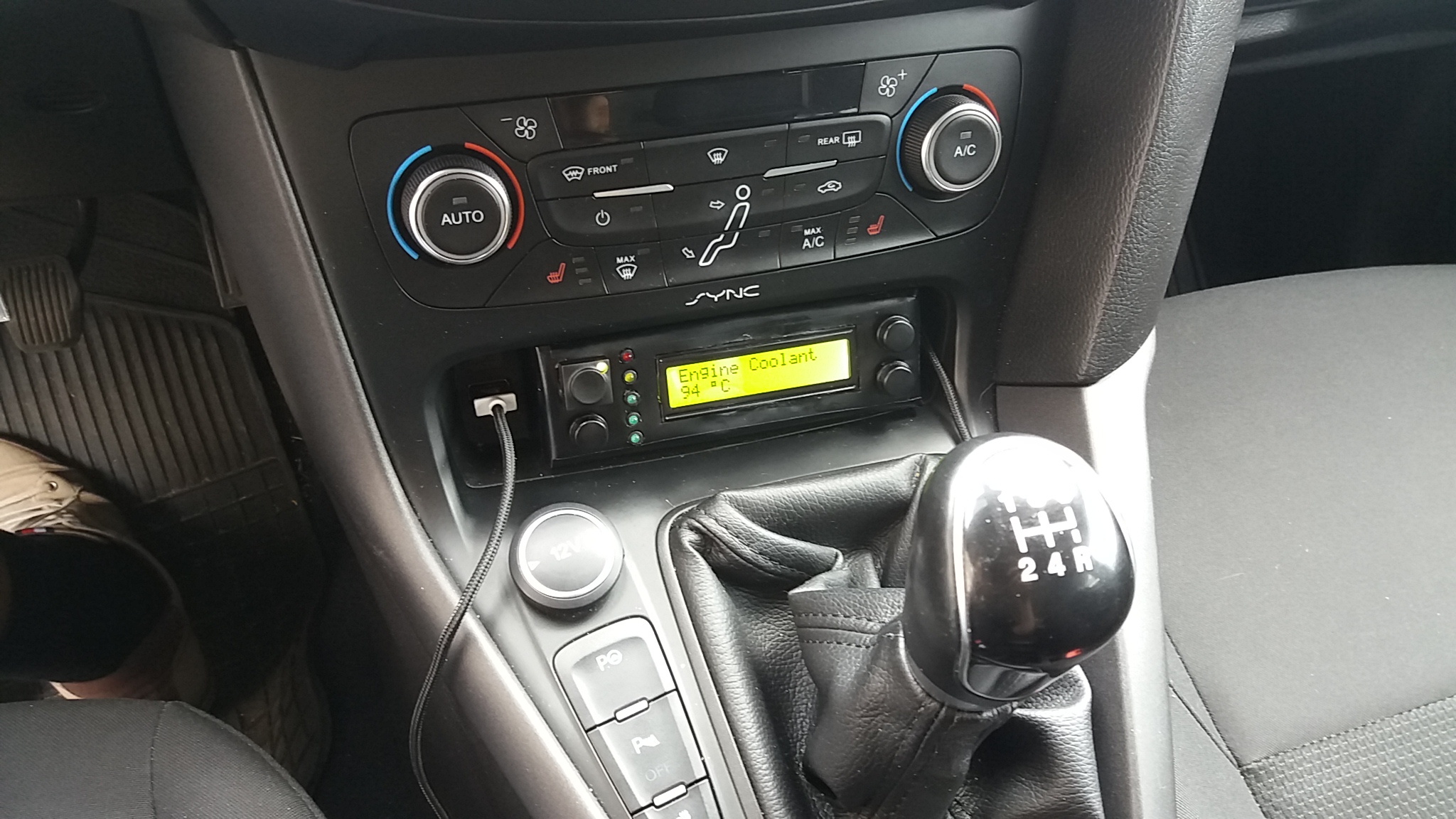OBDII based dashboard.
- There is a led strip (3 green, 1 yellow, 1 red) which is supposed to display the Engine Load
- LCD display shows more information, based on it's mode set by up / down buttons
- Fuel: distance to empty in KMs, fuel level in Liters
- Engine Coolant: coolant temperature in Celsius. Although the car has a built-in gauge on the main dashboard that shows the coolant temperature, that value is not reliable: according to the built-in gauge, engine coolant reaches 90 C much faster than the real value read from OBD2. Also, when the car is climbing uphill, and the weather is hot outside, it keeps displaying ~90 C, but the real coolant temperature can easily go up to 107 C (which is normal, as coolant is under pressure). Probably the car's manufacturer does not want to shock the driver by displaying the real coolant temperature.
- Battery health in Volts. In case the voltage drops under 11.8 V, the battery can still operate (eg. ignition still works), but the battery is close to its end of life.
- On/Off: led indicates if devices is switched on or off. If device is off, it is not making OBD2 calls, but still listens for key press events. In Off -> On transition, esp_restart() is called to start from scratch
- Up (top right): mode selection
- Down (bottom right): mode selection
- Toggle led-strip: switch led-strip on/off
- Polling interval of Engine Load (led strip):
BT_ENGINE_LOAD_POLL_INTERVALininclude/protocol.h - Restart polling Engine Load in case of OBD2 failure:
BT_RESTART_POLLING_ENGINE_LOAD_AFTERininclude/protocol.h - Fuel tank in litres:
FUEL_TANK_LITERininclude/app_main.h - Your OBD2 device's MAC address:
remote_device_addr_1inbluetooth.c - Your car's average fuel consumption:
AVERAGE_FUEL_CONSUMPTION_PER_100_KMininclude/app_main.h - Led strip to display Engine Load or RPM:
LED_STRIP_DISPLAYS_RPMininclude/app_main.h - Long key press interval (to set backlight on/off)
LONG_KEYPRESS_INTERVAL_MSininclude/switches.h - In case your OBD2 device requires PIN authentication, update this line
memcpy(pin_code, "1234", 4);inbluetooth.c
Download BT SPP Server android app, and configure esp32 device to use your phone's MAC address when connecting via
bluetooth. Open BT SPP Server app, and wait until it says "Connected". If esp32 device cannot connect to your server,
open bluetooth settings (eg. list bluetooth devices in range), then navigate back to the app - this usually helps, most probably
android starts advertising when you are at bluetooth settings screen.
Assuming that your device is configured to show RPM, just type 410C1234 into BT SPP Server app (eg. send it to the device).
Device will automatically handle your command as OBD2 response (41) for RPM (0C) with value 0x12 0x34 and it will display it on the led strip.
For Engine Load, use command 41051234 (05 is Engine Load)
You might want to configure poll interval from 200 ms to 10 seconds in include/protocol.h for better testing
Connectors to esp32 based control module
-
[RED ] +5 V
-
[BLUE ] GND
-
[BLACK] Led on the Button (yellow, 110 Ohm)
-
[BLACK] STRIP 1 (green, 110 Ohm)
-
[BLACK] STRIP 2 (green, 110 Ohm)
-
[BLACK] STRIP 3 (green, 110 Ohm)
-
[BLACK] STRIP 4 (yellow, 110 Ohm)
-
[BLACK] STRIP 5 (red, 500 Ohm)
-
[YELLOW] CLK for LCD
-
[BLACK ] DATA for LCD
-
[BLACK ] Button - top/right
-
[BLACK ] Button - bottom/right
-
[BLACK ] Button - on/off
-
[BLACK ] Button - bottom/left
Switches: GPIOs are grounded via 1.5k Ohm resistors. Signal goes through 1k resistors.
Note: Button GPIO orders are screwed up on physical control panel (soldering fail), code follows the order in this repo, above docs might be mistaken, but easy to fix (by code).
espressif/esp-idf commit hash 451f69cc2e11cf45e3a72905c9fb162ca9a08936
This project works with esp-idf at above commit hash. It did not work on a more up-to-date version however - that problem might have been fixed in esp-idf by now.
Get your OBD2 bluetooth device's address (plug into your car, check what device you see on your smartphone).
Update main/bluetooth.c, find remote_device_addr_1 and set it to your OBD2 device's address. You can set a
secondary MAC address as well: remote_device_addr_2, esp32 device will connect to the one that is available.
Whenever you are testing in your car, disable your bluetooth to make sure that device will connect to the real OBD2 device,
not to your phone.
Make sure that EXTRA_COMPONENT_DIRS parameters in CMakeLists.txt are properly set.
Options choose step: 1. idf.py menuconfig. 2. enter menuconfig "Component config", choose "Bluetooth" 3. enter menu Bluetooth, choose "Classic Bluetooth" and "SPP Profile" 4. choose your options.
Not sure why, but make monitor works only if led_strip_init() is not called in app_main.c
Consider changing tick_rate_ms value to 500 ms in app_main.c when debugging, to make sure that BT SPP Server console
is not getting flooded.
